
Boot Hill - Previous Rides
1956 Chevy 1/2 ton - Circa 1976
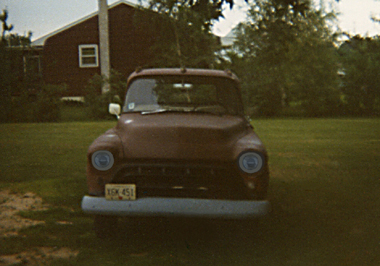
Technically, my first car was actually a pickup truck. Here's the one that started it all. This one I inherited from my Dad when the heater core went bad and he couldn't find a replacement.
I was about 15 at the time so, since I couldn't drive it on the street, I immersed myself in the mysterious world of Bondo, patching all the rust holes in the cab. I experimented with galvanized metal, fiberglass screening and even aluminum screening as backing material for the Bondo. Every so often Dad would run me over to "Red & Black," a huge junkyard in Jamesburg to hunt for parts.
I found an early '60's vintage Chevy pickup in the yard with a good heater which I adapted to fit. Another trip to the yard netted me the front seat out of a 2 door Pontiac Bonneville to replace the ratty original. Since it came out of a 2-door car, it would still tilt foreward for access to the gas tank if needed.
Originally red (with a white bed, bumpers and trim), the only picture I could find shows it in primer, which I never did finish. When I was 16, I sold it to the quintesential collecter, tweed cap, elbow patched jacket and all. He loved the still-present wood floor in the bed as well as the original engine and drive train. So, I sold it to finance my first car, a '69 Chevy Impala 2 door hardtop. Truth be told, I had nowhere near the level of skills, or equipment (to say nothing of the level of cash), required to do this project justice.
1969 Chevy Impala - Circa 1978-1980
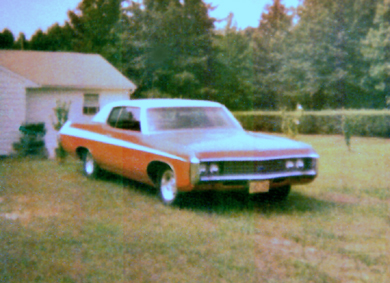
Now it stands to reason that if my first truck were a Chevy, my first car would be one also. The guy across the street just happened to have a 1969 Chevy Impala for sale on his front lawn right after I sold my '56 pickup. It was a 2-door with a 327, 2-speed Powerglide, P/S, P/B and no A/C for which I paid the princely sum of $350 bucks.
Originally it was a faded brown with a white vinyl top. Of course I had another paint scheme in mind. Here are a couple of shots of the car I drove in high school. I had a buddy up the street from me whose Dad was a mechanic. We'd all grown up together and had all pitched in to fix up his first car, a '68 Ford Galaxie 500 2-door hardtop.
He'd painted his Ford in a "Starsky and Hutch" theme, (don't laugh, there were at least 3 of these running around central NJ at the time), since my car had a vinyl roof, I had to modify the stripe a bit. I did all the body work, (my buddy David did the actual painting), the body work and paint-prep alone seemed to take forever and comprised about 90% of the labor involved in making the car look the part.
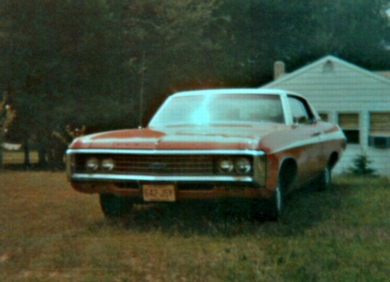
Considering it was my first attempt at bodywork (not to mention his second paint job) it didn't look too shabby when we were done. Needless to say it was a real learning process for all concerned.
Of course David was working as an apprentice mechanic with his Dad, while my Dad said going to school was "my job." The hours were great, but my weekly allowance plus mowing the lawns of a couple of neighbors put a real crimp in my being able to purchase what I felt the car needed. Important stuff like mag wheels, twin pipes and a four-barrel carb. In reality what I ended up with was a set of 7-inch wide aluminum slotted mags, a 2-barrel holley carb (a big improvement over the stock carb), and a hush-thrush muffler.
No dual exhaust, no four-barrel carb, but at least it looked better to me. Heck, even my buddy David had only installed a single "Golden Ram" muffler on his Ford, so neither of us had the status-builder of duals. Also, he was able to afford the "big 'n little" look, but wider rear tires and rims just weren't in my budget. The flat-white stripe actually served a very important practical purpose too. It worked wonders to hide my amateur Bondo work on the holes left from where a chrome strip had previously run the length of the car's body.
1970 Pontiac G.T.O. - Circa 1980-1981
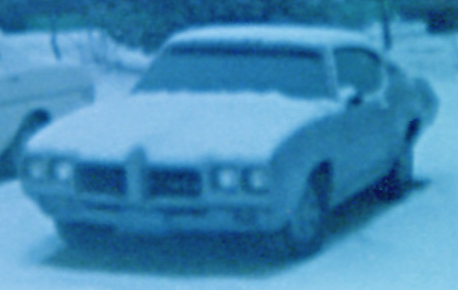
All through high school I lusted after one car more than any other. The Pontiac GTO. I bought all manner of old car magazines at the Englishtown flea market, reading old drive reports and hanging old ads on the walls of my bedroom. In 1980 I sold my Impala and began looking in the Want Ad Press for what I wanted.
After looking at a few that were beyond my reach, I finally found a silver GTO hardtop sitting in a gas station in northern NJ. I bought my first "Goat" for $850 bucks in September of 1980.
This car was 98% rust free, ran great and I envisioned myself keeping it forever. Ah the optimism of youth. I know what you're probably thinking. This was my dream car, so where are all the other pictures? Well, for starters, my photography skills were in their infancy and those old 126 Instamatic cameras were hardly state of the art. Second, I bought the car in late September, but didn't snap this shot until 2 months later. I seem to recall there were only 2 shots left on the film cartridge. Before I could get around to buying more film, I'd already wrecked it.
Prior to the accident, all it really needed was a new paint job. The interior was cherry, no huge dash splits or rips in the seats, heck even the A/C would blow snowballs no matter how hot it was. A moment's miscalculation on a snow covered road and all I was left with was a pile of junk.
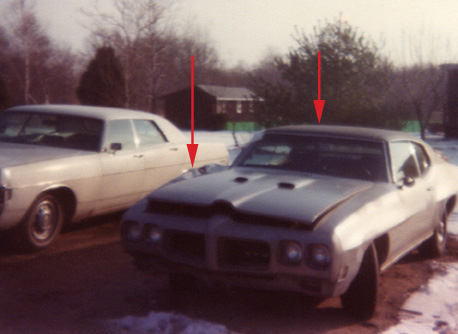
The two red arrows indicate where the car impacted against the telephone pole and the guide wire. At the end of our road was an S curve that went around a graveyard. I went into the curve too fast and over-corrected when the back end got loose. There was a slight downgrade, so when I tried to steer out of the skid I was sliding sideways downgrade.
I remember seeing the pole looming, so I floored it. I figured if I could just clear the pole, I'd end up in a nice flat cornfield. No such luck. I had plenty of power; unfortunately even with the snow tires I had zero traction.
Since this took place before seat belt laws were ever dreamed up, (let alone enforced by an increasingly draconian government), naturally I wasn't wearing mine. So when the car hit the pole, I got my first real-world encounter with a little thing called inertia. I ended up with my head in the passenger's side foot well. My thick sheepskin coat saved my shoulder as I was thrown across the floor shifter, which I bent. 8-Track tapes were all the rage at the time, so when the glove compartment popped open I found myself buried in them. Stunned, I lay there for several minutes before pulling myself back up to a sitting position, and turning off the engine. Once I'd averted any danger of fire I went to a house across the street from where I crashed for help.
To those who may be wondering, yes I now wear my seatbelt... most of the time. Of course back then kids could ride their bikes without being forced to wear helmets! Living in America back then was fun, uninhibited and guess what... somehow, we all survived to tell about it!
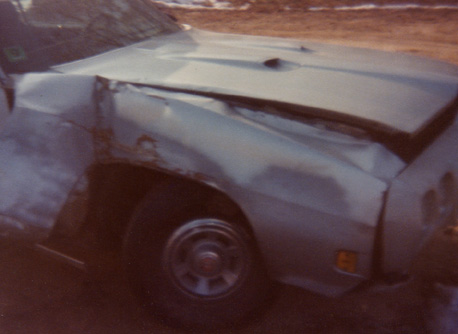
This shot shows the damage done to the front end by the cable. Once I recovered from the shock of seeing my dream-car in ruins, I began plotting and planning a way to resurrect my goat. Having memorized the history of the car's origin at the factory (that of originally being an option on the Le Mans series), I decided I'd do what GM did.
I'd buy a "donor" Le Mans and transfer all the special GTO equipment to the undamaged body/chassis. Once again I began picking up the "Want Ad Press" (a central NJ automotive buy-sell-swap periodical), as well as scouring the local newspapers for possible donor cars.
It was at this point I inherited my Dad's cast off 1971 Dodge Polara 4-door hardtop, which I used for going back and forth to college as well as parts-chasing. It was no muscle car, but it was transportation while my goat was laid up and the price was right. Besides, with a 360 V-8 under the hood it was no slug off the line either, so all-in-all I lived to drive another day.
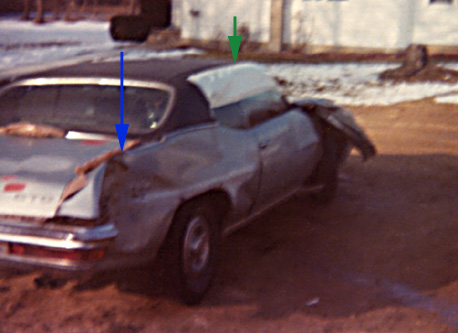
The blue arrow shows the telephone pole damage to the rear fender. You can also see another angle of the damage done to the front fender by the cable. The green arrow shows how the side window was bulged out beyond the roofline, indicating a bent frame. There's nothing quite like looking up through the windshield of your car from the passenger side floor to watch the remnants of a telephone pole slowly swing back and forth over you.
To add insult to injury, I was charged for the replacement cost of the telephone pole in addition to the towing charges. It was a truly traumatic experience for a young driver. I'd previously thought myself both invulnerable and immortal. It was quite humbling to discover I was neither.
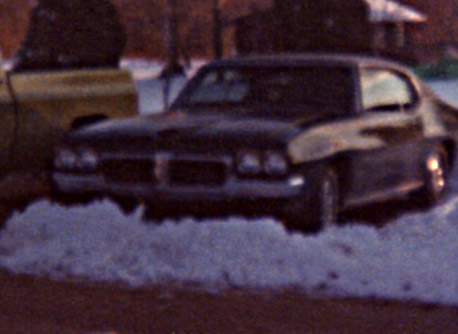
In February 1981, I found my "donor car." It was just what I needed, a rust free body and a straight frame. I'd have been better off with a Le Mans Sport with bucket seats, but I grabbed the first thing that would serve my purpose. By the way, the area in which you see the car parked is where all the work took place. No garage, no carport, no lean-to... just a nice sand driveway. Of course the sand did help to absorb the inevitable fluid leaks that took place.
Periodically my buddy up the street (now a full-fledged mechanic himself), would stop in to check on my progress, fascinated with what I was able to do with nothing other than a good set of hand tools and an innate ability to carefully dismantle all that was salvageable from my comatose GTO and then re-install all the parts into the Le Mans. I had no manual to follow, but most of the work had a natural progression to it once I got started, all in all the part-swapping-process took about 6 months of work to complete.
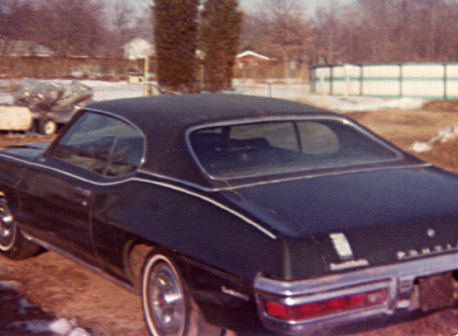
Being continually exposed to the weather presented a real challenge. Of course, once I got to a certain point, I could climb inside and work on the interior when it rained. Working on sand, the engine hoist immediately sank into the soft surface once I had some weight on it. So once the engine was clear, I rolled the GTO carcass out from under it and then shoved the motor-less Le Mans into position. Yeah, it may sound crazy, but I was driven to rebuild my GTO and besides... it worked.
Of course transplanting the power train as a unit (trans attached), made things interesting too. Wherever I wanted to jack the car I had a 2x3 foot square of 1/4-inch thick diamond plate I would shove under the car to place the jack on, otherwise I'd simply pump the jack down into the sand. Cement blocks and pieces of 2x6 lumber provided additional support. While it was up in the air, I removed the rear end, (trailing arms, shocks and all), then rolled the GTO assembly into position.
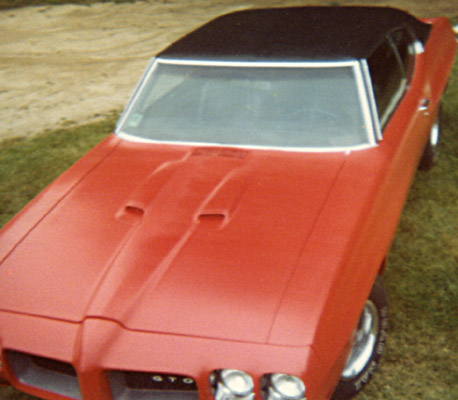
Finally, after all the hard work, I painted the GTO with red lacquer, which is why the paint has a flat appearance. I took these shots before the paint cured enough for me to compound out. The polishing compound really brought out the shine.
I tried to take some more dramatic shots with my trusty Kodak 126 Instamatic. The previously dark green vinyl roof was dyed black although the center seam was still different from the two side seams on the original GTO. Swapping the bucket seats out of the GTO for the bench seat of the Le Mans presented another challenge.
Not knowing how to weld, cutting the seat brackets out of the goat and re-installing them in the Le Mans was not feasable. So, I carefully measured the original bucket seat brackets so I knew how thick a stack of washers to use when I bolted them into the LeMans floor pan, so they'd sit in the car properly. I even swapped the VIN number plate on the dashboard so I could register it as a real GTO.
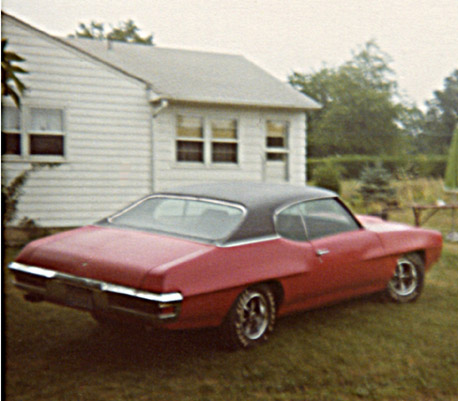
This would no doubt horrify the poor soul who may have bought this particular car as a blue chip investment, but that's just tough. I wasn't trying to cheat anyone and the car was as much of a GTO when I was done as when it rolled off the line at the factory.
I eventually sold it for $1,800 bucks, roughly doubling my original $850 investment. Some food for thought the next time you see one of these in Hemmings for 80,000 dollars. Ridiculous!
If you haven't noticed, I have no love lost for those who've taken this hobby out of the hands of the everyday men and women who really enjoyed them. You have to realize, that when I restored this car, I got a replacement front fender from a junkyard. I fixed the tiny crack in the dash with some liquid vinyl, a piece of vinyl textured material that more or less matched the dash and "borrowed" Mom's iron to "vulcanize" the repair.
There was no Year One no Just Dashes no resources other than the Pontiac dealership (legend had it GM kept parts in stock for 10 years or some such) or the local junkyard... period. Then somebody wrote a book valuing them as "collectables" and suddenly the weren't old cars anymore, they were "rare," and of course that translated into "extremely valuable." Okay I'll get off my soapbox now.
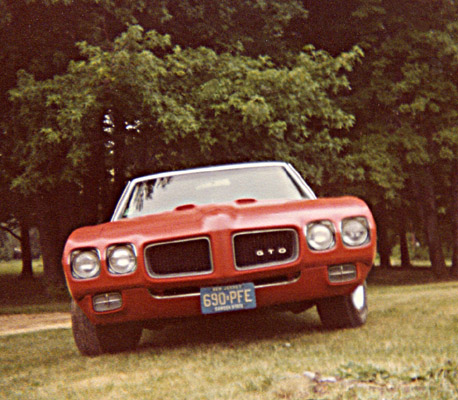
This low angle shot actually makes it look like a ragtop, although that wasn't my intention when I shot the picture. One thing I really loved about the GTO was, it was a smooth running, docile, reliable grocery-getter as long as you kept your foot out of it. Stand on the loud pedal though and you were in for a real treat... in addition to a grin that would need to be pried off your face. I pulled out of my buddy's driveway one day and punched it. I must've laid rubber for 80 feet.
In 1970, GM really got the design of their midsized cars down pat, Olds, Pontiac, Buick, it didn't matter, they all looked cool. The only "custom" touch I added was a set of the timeless Rally II wheels in place of the original wheel covers.
If the car had a major weakness, I would point to the shifter for the Turbo-Hydromatic 400 tranny. The GTO shifter was supposed to shift the Turbo-400 tranny one gear at a time... if you pulled the shifter all the way back and then with each shift you applied pressure to the right for one gear at a time upshifts. Damn thing never worked right.
As much fun as this car was in the stoplight grand prix, you needed to pick your target with care. A buddy and I were on our way home from junior college, each doing about 40mph and decided to just floor it in an impromptu "flying mile" race. It was no contest. His 440 equipped '71 Satellite moved out like my car had suddenly run into quicksand! His Mopar was just a complete and total torque monster.
I still remember the guy who bought the GTO for his son. He'd been peppering me with lots of questions the whole time, then... he asked me how the gas mileage was. With my eyebrows up in my hairline (figuring I was about to torpedo the sale), I told him "well, you could probably get about 10-12 mpg... if you take it real easy." "Well at least you're honest about it," he said and then showed me a picture of the one he'd owned as a younger guy. You know, I sometimes wonder what ever happened to this particular car.
1970 Pontiac G.T.O. (4 Speed) - Circa 1981
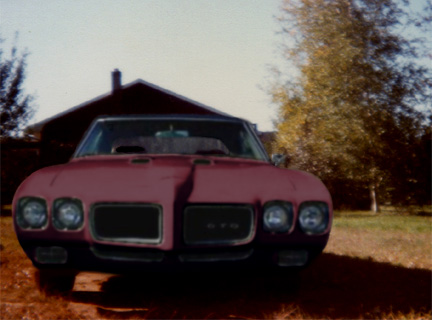
My second "goat." Or more accurately, my second attempt to capture lightning in a bottle. What a disaster! This one had really been abused when I got it. When I pulled into my yard after buying it, I stepped on the brake pedal and it went to the floor as smoke billowed out from underneath. The brake line had split due to corrosion and sprayed brake fluid onto the left muffler. I crawled underneath, and was horrified by what I saw.
The car had spent much of its life at the Jersey shore and the salt air had really taken its toll. I had to replace most of the brake lines just to be able to drive it. I'd been in a hurry to get another GTO and was blinded by the mint interior with rally gauges, 4-speed stick and front disc brake options. I never crawled under it. Stupid move. The floor pan, trunk floor, hell, even much of the frame was rusted through with lace. Yeah, I really got taken to the cleaners on this one. I bought it in May and sold it in October, so I only have one shot of this one.
The kid I bought it from said he'd been following someone in the rain and couldn't stop in time, which had bent the Endura bumper back and under, on the passenger side. I found a bumper shop that would straighten it, but I had to remove the Endura "skin" from the metal bracing underneath and take him both sections separately. What a job that was, I needed a breaker bar and lots of penetrating oil just to break them loose.
The drivers door had a dent right in the character crease, so I replaced the whole door with a lemans unit and primered it with Rustoleum red lead. It was at this point that some helpful soul put some sort of "sealer" in my gas tank. When I tore the fuel pump apart it was packed with a substance that best resembled a kid's uninflated (blue) rubber balloon. To this day I don't know who did it, (let alone why) or even where it happened. I had to drop the tank, flush it, replace all the fuel lines and the fuel pump to set things right again. I'm sure it's the only car to ever have a fuel filter before the fuel pump and another one before the carburetor. The fuel filter was the only thing that saved my carb, while my fuel pump was packed full of whatever that blue stuff was. I use locking gas caps on my car to this day thanks to whoever did this to me.
The greatest kick I got was running her through the gears, there was nothing like it, of course that probably brought my gas mileage to single digits but boy was it ever fun! Even when I took it easy, I'd still be taching about 3,000 rpm in fourth gear At 55 MPH since it had 3.90 gears. Once again I bought a donor Le Mans with dreams of making the goat whole again. But as you might imagine, my parents patience was getting a bit thin with all this car restoration work, so I sold the goat in October after only owning it for 6 months. It sure was a fun 6 months though.
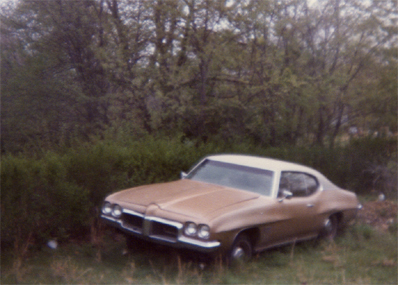
Once I abandoned the 4-speed GTO rebuild, I was left with this. So, what to do with a donor car I no longer needed? All it lacked was an engine, so... I worked out a deal with a buddy who was fixing up a '69 Buick convertible. He bought a donor car for its front-end sheet metal and I went in "halfers" and grabbed the engine. Since BOP (Buick, Olds, Pontiac) all used the same bolt pattern, I knew the engine would drop right in.
Uh, that is, in theory anyway. I spent one whole weekend trying to get the Buick engine in and it simply wouldn't line up with the trans. Finally, after much aggravation and frustration, I discovered that the previous owner had loosened the trans cross member and it had shifted to one side of the frame. Once I realized that, and lined it up properly once more, everything fell right into place. I cobbled an exhaust system up out of two turndowns, two mufflers and no tailpipes.
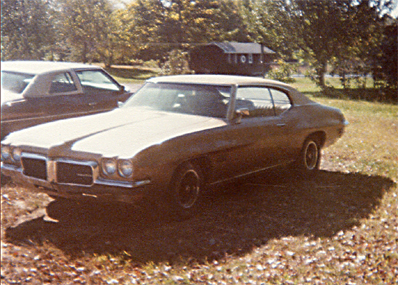
It looks pretty good in this shot doesn't it? You know, I wish I'd actually kept this one. This one was a real LeMans Sport, with buckets, the center console and dual outside rearview mirrors. The original paint still had quite a shine, some Turtlewax really worked wonders. The hood, (which had a large dent in it when I bought it), I replaced with one from a buddy's junkyard. I swapped him some other parts for it as I recall. If I'd had the cash, a simple dual exhaust system would've made this a really sweet ride.
The car came equipped with two under dash gauges, one of which was an ammeter. That's why I wasn't concerned about the "GEN" light; I knew it was charging by looking at the gauge.When I finished, it ran fine with the one exception that the "GEN" light would not go out. My VOM told me it was charging, so I removed the GEN bulb, and it was ready to sell. I sold it to a couple of brothers down the street for $800 bucks.
1973 Satellite Sebring Plus - Circa 1982-1983
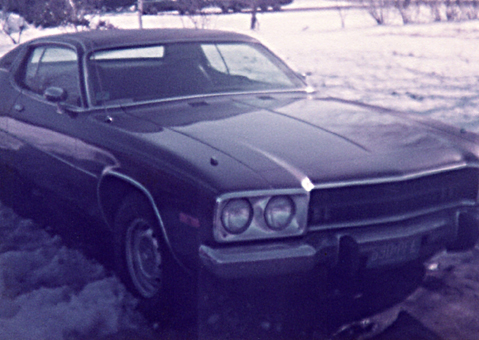
After my 4-speed GTO travesty, I decided a change was needed and shifted my allegiance to Mopar. I still preferred a "mid size" platform and settled on a '73 Satellite Sebring Plus. Here's a shot taken shortly after I brought my Satellite home.
My buddy had lots of Mopar stuff so rally wheels had already replaced the stock wheel covers. The car was a dark gold/brown color with a gold vinyl roof and light gold interior. I think I paid $1300 for it at the time. In retrospect, it was nice little car with the standard 318.
If you've never owned one, the chrome things on the tops of the front fenders were the turn-signal indicators. A novel idea that worked really well. Our '71 Dodge Polara had the same setup.
The first time I got caught in a downpour I discovered that the car had 3-speed wipers. I'd never had a car with 3-speed wipers before or since. The car also had full gauges and the infamous Slap-Stick shifter for the Torqueflite automatic. The console between the buckets may have been plastic and fake wood, but the shifter worked great.
The Mopar guys spent their money in the right place. From Park, you press the thumb button of the floor shifter T-handle and pulled it all the way back into low. Then slap it once into second, slap it again and you're in drive. You couldn't go any further into neutral without thumbing the lock out button first. Genius!
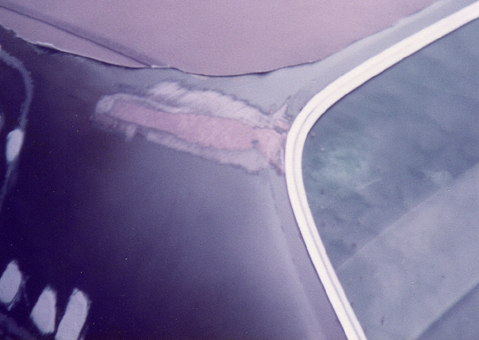
Here's a shot taken as modifications were in full swing. Since I was creating a Road Runner duplicate, the vinyl roof had to go. It didn't help that the vinyl didn't go all the way to the drip rails. Instead there was about 2 inches of paint between the drip rails and the vinyl roof side trim. When I removed the trim I was left with little studs resembling nail heads that had to be ground down. The Bondo in this shot was used to fill the holes left by removal of the stock emblems.
I also didn't know that cars equipped with vinyl roofs had rough-finished body seams between the roof and the rear quarter panel.
No problem Jim, pass me more Bondo. Again taking photos of the process wasn't a priority for me back then. But it gives you an idea of how much work went into preparing the body for the black finish; which I knew would be unforgiving where imperfections were concerned.

Ah, the finished product, resplendent in black Imron enamel, which I laid down myself. Incidentally, the hood as you see it here, is the way I bought it from a guy in north Jersey. This was the only time I ever purchased a body part and painted the car to match. I spent untold man-hours sanding the body, not to mention cleaning the grille and taillight bezels, going over them with a several Scotchbrite pads, then painting them flat black for that all-important performance look. I used a razor-blade scraper to remove the pinstripes, which had been applied with a pinstriping roller tool.
I remember going to the inspection station and getting rejected for the signal lights not being properly mounted. The car was in primer, almost ready for paint, and the jabronie at the inspection station "ordered" me (these guys really took self-importance to a whole new level) to come back when the lights were properly mounted. My Dad, (true to form) told me I was a horses rear end or some such, for going through the inspection line like that. Back then, when you got rejected, you had 30 days to come back with the necessary repairs made. Or else, I suppose. I got the car re-inspected some 6 months later at a different location. It's so liberating to live in SC where there is NO INSPECTION whatsoever! Yabba Dabba Doo!
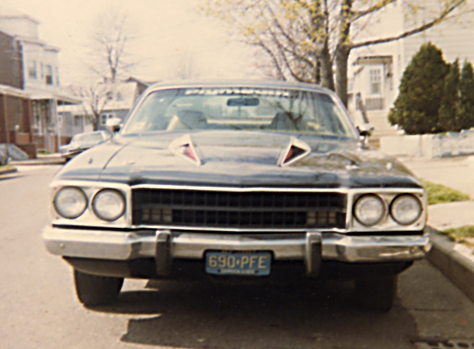
Here's a shot taken at my buddy's house in beautiful downtown Trenton NJ. This was from my not so subtle phase of car building. Not seen in this shot are the Lakewood traction bars and plethora of speed shop stickers on the rear quarter window. I also installed a mini 3-spoke chrome steering wheel from a speed shop. I even went so far as going to the Dodge dealer for a "beep-beep" horn. I was a little disappointed it wasn't painted purple with the "voice of the roadrunner" decal like the original had been.
So, how was the performance with the new 360 under the hood? Actually, not too shabby. With less weight to move, the 360 engine turned out to be a good compromise of performance and thriftiness. Of course it was no 440!
1971 Chrysler Imperial Brougham - Circa 1982
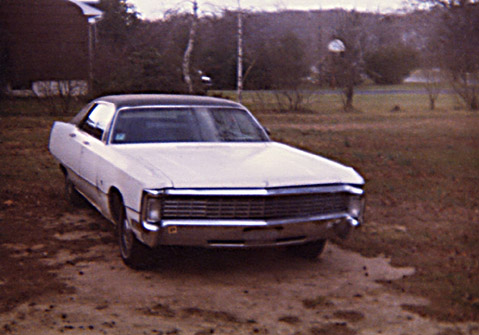
What the...? A brief explanation is due here to explain what a budding young gearhead would want with a boat like this. Well, once my "Road Runner" looked the part, I found it to be seriously lacking in the horsepower department.
A discussion with my uncle regarding my Satellite's lack of oomph, led me to this. Apparently, the woman who owned it was making a left-hand turn into her driveway and a kid in a Camaro whipped out to pass the slowpoke just as she cut the wheel. The Camaro ended up in a ditch while the Imperial had a dented driver's door, creased driver's front fender and bent front bumper. For $250 all I was after was the 440 under the hood!
I never got to go through with the engine swap though. My Dad (probably thinking I'd surely kill myself if I built this bomb), persuaded me to use the 360 from the old '71 Dodge we had. The same one in the background of some of the G.T.O shots in this section. Well, I swapped the 318 in the Satellite/Road Runner for the Dodge's 360 in the end. I don't remember all of the details, but I do remember replacing the door and fender on the Imperial and selling it to another Mopar fan. He wanted the big 440-power plant too.
1976 Pontiac Grand Prix | Golden Anniversary Edition - Circa 1984-1986
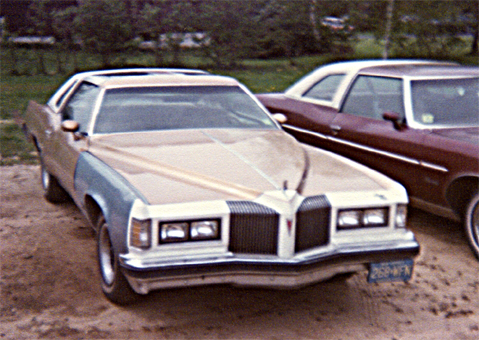
Then there was Goldie. I decided what I really needed in a car was the power and style of the G.T.O. with some luxury touches thrown in. Originally, I was looking for a 1977 model, since I liked the front end styling better. I looked at a few (one that had what looked like foam fire extinguisher stuff under the hood), and then I found Goldie.
The guy was selling it because he'd had the car re-painted... and his wife ran into a pole one week later. She couldn't have been going too fast, as there was only sheet metal and fiberglass damage the frame having escaped unscathed. I guess he was rather disgusted with the whole situation, so he'd put it up for sale.
I looked at it and knew it would need a new front bumper, passenger side fender and fiberglass header panel where the headlights and grille were mounted. I took this shot shortly after replacing the damaged tin with some junkyard parts. I did this in the early spring and really needed warmer weather before I could spray them to match. My Dad's '76 Bonneville can be seen alongside my GP.
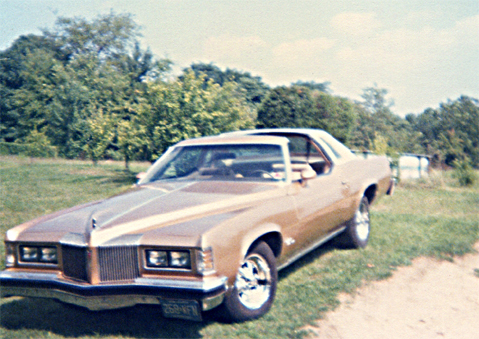
Another guy had made the seller an offer, so I made a better one. The seller said he wanted to give the other guy a shot first, but since there was no deposit left, the car was still fair game. He told me to give him a call the next day. When I did, he said "Come pick up your car."
When he handed me the keys, I was surprised that the key fob had the word "Goldie" imprinted on it, so I can't take credit for naming her. Guess that's how he actually referred to it.
My Mom had decreed that I could not have a convertible, convinced I'd flip it over and kill myself. So, a car with T-Tops represented a loophole around the parental edict. The only problem was, the damned things leaked. Especially the one on the driver's side! Of course! Whenever I drove it in the rain, I had to sit almost over the hump or get a wet butt.
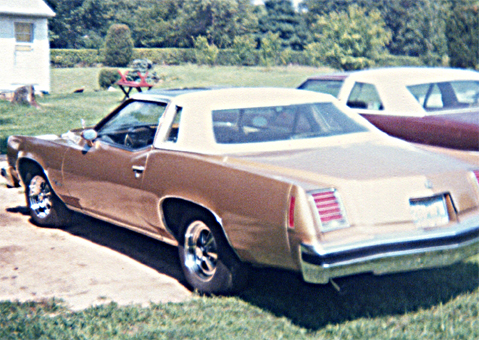
I did manage to seal the driver's side by laying down a thin bead of silicone around the perimeter of the rubber gasket that was supposed to seal the glass panel against the elements. Of course when I did that, I defeated the whole purpose of having T-Tops in the first place. Parents 1, wise guy kid, zip.
Of course this car had its problems too. The original 400 threw a rod one day when I was taking off from a stoplight, so I replaced it with a 455 from a '73 Pontiac Bonneville I bought from a junkyard. Big mistake! The first time I drove it home after the engine swap I looked like Mr. Bond after activating his smoke screen.
I did a compression check and found out which piston was blowing all the oil out of the right exhaust pipe. So once again I tore into the engine (doing a one-holer), replacing the offending piston, rings, and con-rod just for good measure. That made the car quit smoking for good.
Epilogue: Ah, but she still had one last trick up her sleeve. Shortly after I got the engine sorted out, the tranny went and the car sat for about 6 months while I saved up to have it rebuilt. While it sat, one of the tires went flat and Mom turned up the heat for me making the yard look like a junkyard. After all this, I'd finally had it and decided it was finally time for a new car. That car would be my 1987 Monte Carlo SS.
1976 Chevy 1/2 ton - Circa 1986
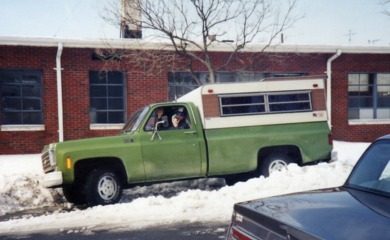
Ah the lime-green '76 Chevy C-10. Another one I inherited from my Dad (the successor to the '56 Chevy), and ran for years as my "winter vehicle" to save the Monte from the salt. With no A/C it was a real sweatbox in the summer months. It fried a piston in the mid '80s (while Dad was still running it), due to detonation.
We did a "one-holer" piston ring replacement (not to mention some honing to clean up the wall of the cylinder), and she was back in action. Once I took over ownership, I replaced both front fenders and the rocker panels which had succumbed to the winter salt. I also sanded the "scabby" front bumper with some 60 grit, primered it with Rustoleum, then shot some rattle-can white on it. The improvement was considerable.
In 1990 I traded it to a buddy of mine for a 1980 Chevy Caprice wagon. The truck had an inline 6 and an automatic, no other amenities. The wagon was loaded, and he wanted a truck, so we swapped. This picture was taken in the early '90's shortly before my buddy sold it. If my amateur bodywork didn't let go, it may still be running somewhere. Other than that one piston issue, the running gear was bulletproof.
1980 Chevy Caprice Wagon - Circa 1990-1998
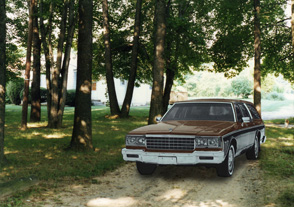
Okay, I know what you're thinking... that thing's not a truck. Yeah, strictly speaking it's not, yet I called upon it to fulfill most of the functions I'd previously doled out to my pickup. Equipped with a pair of coil-over shocks, I trailered a car from NJ to SC and once there hauled full sheets of sheetrock home to work on my Dad's house.
The puny little 267 V-8 having been thoroughly fubar'd (thanks to Hunter Chevrolet) meant I needed a new engine. I went to a local junkyard and bought a 350 V-8 out of a Chevy pickup. Now it had the heart of a pickup in addition to being used like one. The extra cubes and torque were just what the car needed. I even fixed the A/C and fabricated a custom bracket to adapt the cruise control bellows to the new engine. This was the engine swap project that convinced my wife that I was a certified mechanical wizard. I went so far as to take a short video to document where everything went before tearing it down. That turned out to be a real big help when assembly became the order of the day. My digital camera now serves the purpose much better.
I went to a Chevy dealer in Hendersonville where I was... now what's the best phrase to use here... (metaphorically speaking) wait, I have it, where I was ANALLY PROBED! All I wanted was to have them tune the car up a little and adjust the rocker arms. As "Ahnuld" would say... "Big Mistake!" To this day I don't know what they did, but the damned thing began spewing oil from everywhere! I'd sit at a traffic light (clouds of oil smoke billowing from beneath) and folks next to me would tell me my car was smoking. Yeah, nothing get past the locals down here.
After several trips back (wherein I was assured my camshaft was shot among other things) explaining the car didn't have this problem before I brought it to them, I was given the bums rush out the door. I would've needed a lawyer to get any satisfaction, so I chalked it up to stupidity on my part (trusting a dealership mechanic) and decided to fix it myself. By the way, the dealership was called Hunter Chevrolet, so if you want both your ride and yourself to be Screwed Royale, take it to them. There... you know what they say about paybacks... and I've got a long memory!
1986 Ford F-250 - Circa 1999-2001
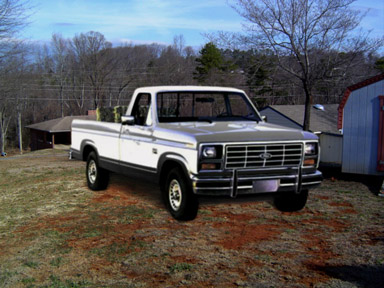
The first truck I bought upon moving south, my first Ford, and my first 3/4 ton model, an F-250! We'd bought a fixer upper house and had no way to haul crap to the dump. This one was really overkill for my needs (an F-150 would have been much better), but I bought the first thing I could afford. I paid about $2,600, and sporting the "southern standard equipment" glass-packs, it was a real noisy beast.
It had a 351 Windsor, automatic, P/S, P/B and A/C it served me well despite its thirst for fuel. I loaned my Monte SS to my Dad when his car got totalled and going 20 miles one way to work for 5 days required 2 fill-ups per week. I found it extremely handy to haul home some 250 bags of sack-crete for a concrete job no one wanted to do for me.
Probably would've busted the springs on a smaller truck, so who's to say I didn't need an F-250 after all. Eventually though it proved too costly to feed, so I sold it to a farmer for just what I paid for it. Of course he got it after I did a brake job, upgraded the shocks and installed all-new LT rated tires. Yeah, it leaked oil a bit, but he got it in a lot better shape than I did, so my conscious was clear.

© Copyright 2009 Brian Petruska | Top | Upgrades | GM Performance Parts | HTML Now! | Apple | Comments |